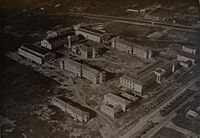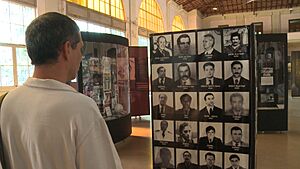Navy Petty-Officers School facts for kids
Quick facts for kids Navy School of Mechanics |
|
|---|---|
|
Escuela de Mecánica de la Armada
|
|
 |
|
| Former names | Escuela Superior de Mecánica de la Armada |
| General information | |
| Location | Núñez, Buenos Aires |
| Country | Argentina |
| Official name | ESMA Museum and Site of Memory – Former Clandestine Center of Detention, Torture and Extermination |
| Type | Cultural |
| Criteria | vi |
| Designated | 2023 (45th session) |
| Reference no. | 1681 |
The Higher School of Mechanics of the Navy (in Spanish: Escuela Superior de Mecánica de la Armada, or ESMA) is a place in Argentina with a very important and difficult history. For many years, it was a school for the Argentine Navy. But later, it became a secret prison during a dark time in the country's past.
From 1976 to 1983, Argentina was ruled by a military government. This period is often called the Dirty War. During this time, the ESMA building was used as a secret place to hold people who disagreed with the government. These people were called "subversives." Inside ESMA, many prisoners were treated cruelly, and thousands disappeared. The military also took babies born to mothers who were imprisoned there. These babies were given to other families, and their real identities were hidden.
Today, the ESMA building is no longer a school or a prison. It has been turned into a museum called the Space for Memory and for the Promotion and Defense of Human Rights. The museum honors the people who suffered there and teaches visitors about this important part of Argentina's history. In 2023, UNESCO made the ESMA museum a World Heritage Site to remember what happened there.
The original navy school moved to a new location in 2005 and was renamed the Navy Petty-Officers' School (ESSA).
Contents
History of the ESMA
The ESMA has a long history that changed dramatically over time. It started as a place of learning but became a place of great sadness before being transformed into a place of memory.
The navy school was founded to train young people for careers in the navy. The building that became famous was built in the 1920s in the city of Buenos Aires.
Each year, thousands of young people applied to study at ESMA. They could learn subjects like electronics, aeronautics, and marine engineering. Students lived at the school during the week and took many hours of classes. After finishing their studies, they could work for the navy or in other jobs.
The main building had offices and a patio. Other buildings housed the students and officers. During the Falklands War in 1982, many students from ESMA were sent to fight.
In 1998, the president of Argentina, Carlos Menem, decided to move the school. The old ESMA building was set to become a museum to remember its dark history. The school itself moved to the Puerto Belgrano naval base and is still in operation there today.
A Secret Prison
During the military government from 1976 to 1983, ESMA's purpose changed. It became the largest secret detention center in Argentina. A special military group, called Task Unit 3.3.2, ran the center. They were ordered to capture people who were seen as enemies of the government.
Almost 5,000 people were taken to ESMA as prisoners. They were held in secret, and their families often did not know where they were. This is why these people are often called los desaparecidos, which means "the disappeared."
What Happened Inside ESMA?
The ESMA building was changed to hold prisoners. The basement had rooms where prisoners were questioned and treated harshly. The upper floors were where the officers lived.
A part of the third floor was called the "capucha," which means "hood." Prisoners were kept there in the dark, often chained and wearing hoods over their heads. They were isolated and lived in constant fear. The conditions were meant to break their spirit.
The people targeted were often those who disagreed with the military government. Anyone suspected of opposing the government could be taken to a place like ESMA. This created fear throughout the country.
The Fate of the Prisoners
Very few of the people taken to ESMA survived. When prisoners were told they were being "transferred," it usually meant they were going to be killed.
Survivor Stories
A small number of people survived their time at ESMA. Their stories are very important because they help us understand what happened.
One survivor, Ana María Martí, described the constant fear inside the center. She explained that the main goal of the officers was to cause as much suffering as possible. She witnessed many of her fellow prisoners being taken away, never to be seen again.
Another survivor, Susana Reyes, was pregnant while she was a prisoner. She described how the guards treated the women cruelly. Fortunately, she was able to escape before her child was born. Her story, and others like it, show the bravery of those who lived through this terrible time.
A Place of Memory Today
In 2004, the Argentine government officially turned the old ESMA building into a museum. It is now called the "Space for Memory and Human Rights."
The museum's mission is to honor the victims and make sure that such terrible events never happen again. It serves as a powerful reminder of the importance of human rights. Argentines use the museum to share the stories of those who were lost and to teach future generations about the dangers of a government that does not respect its people.
The museum shows visitors what the building was like when it was a prison. It helps people understand the history of the Dirty War and the courage of those who resisted and those who survived.
See also
 In Spanish: Escuela de Mecánica de la Armada para niños
In Spanish: Escuela de Mecánica de la Armada para niños
- Pozo de Banfield





